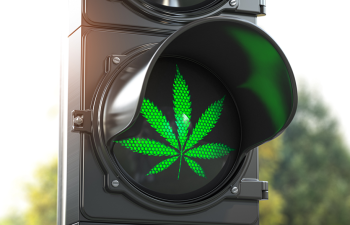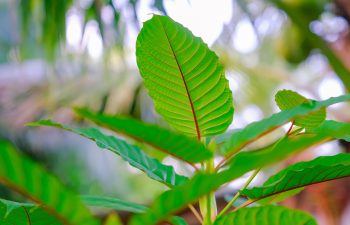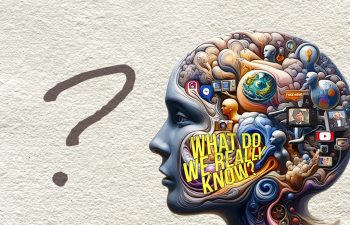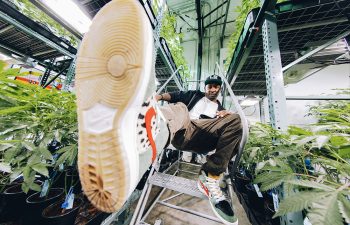Psychoactive Mushroom with a Long and Fascinating History
By Eva Berlin Sylvestre
In the shadowed depths of the University of Cologne’s oldest alchemy laboratory, Albertus Magnus mixed potions with foundations of amanita muscaria beneath the eerie glow of candlelight, intent on concocting a solution to rid the university of its persistent fly problem. Students whispered in rumor and curiosity about the ancient scholar’s late-night experiments with the crimson caps, and before long, they had their answer. In a saucer of milk laced with an amatoxin that both attracted and killed the winged nuisance that plagued the ancient school, a new pesticide was born.
Centuries later, in a forest glade near England’s Oxford University, Lewis Carroll sat, quill in hand, with pages of “Alice in Wonderland” scattered about him. Stirred by the enchanting mushrooms that dotted the forest floor, he let them speak through him, forging magical doorways to reveal Alice’s adventures. The tale — one that began as stories told to his children — unfurled before him in its entirety, giving us Wonderland and its access to mesmer and ethereal delights.
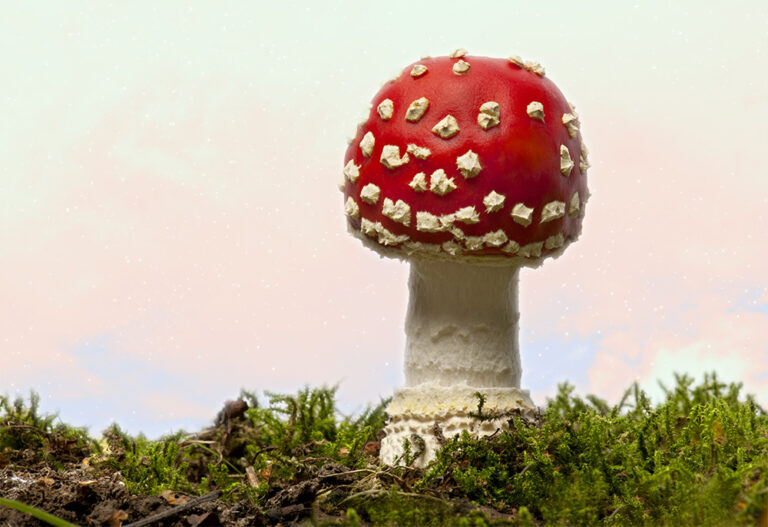
You already know amanita muscaria, HeadQuester. From depictions of the red-capped beauty in the Mario franchise to the blacklight poster before which your middle-school sweetheart cheated on you (condolences), the iconic mushroom stands as a hallmark in both the annals of botany and folklore.
Native to temperate and boreal regions, amanita muscaria (also known as fly agaric) has sealed its place in the zeitgeist of various cultures due to its psychoactive properties. Though it belongs to the amanita genus, which houses several toxic varieties, amanita muscaria itself is classified as less toxic, yet still capable of inducing modest hallucinogenic experiences.
For many frequent fliers of Air Muscaria, the trip is usually more mild than wild. Though not as common in a daily microdose regimen as mushrooms in the genus psilocybe— “magic mushrooms,” if you will — some users revel in the benefits of a daily reality-tweak via amanita. One of those is Amanda Taylor1, 33, who procures dried caps from an online source and brews a nightly tea before bed.
“I get the blankets set up perfectly and put my water and phone close by on the nightstand [after I finish the tea],” she says. “Sometimes I get dizzy if I’ve made it too strong, and I can’t get up, so I need to have those readily available.” Dizziness is a common occurrence, especially for newer users, but even connoisseurs can botch the batch. Processing and dosing is tricky, so it’s ill-advised for the untrained to try their hand.
Explicitly, fly agaric should be decarboxylated to transform its ibotenic acid — the powerful neurotoxin it contains in abundance — into the more desired muscimol, which also exists therein, though in negligible amounts. Forgoing (or all-out fumfering) the decarb can result in an ibotenic-heavy experience with the potential to induce tremors, vomiting, seizures, delirium, and in some cases, death. As the two chemical components are similar in structure, ibotenic acid can be thought of as a precursor to muscimol, so striking a desirable balance between the two is best left to the big brains in lab coats.
“The decarboxylation process removes a carboxyl group-COOH- from ibotenic acid, transforming it into muscimol,” says Hunter Donahue, who holds a B.S. in Agriculture from the University of Georgia. “The fly agaric is often labeled ‘poisonous’ in identification guides, a description many mycologists would disagree with,” she adds. “When properly prepared and thoroughly cooked, amanita muscaria is safe to eat in moderation, just like any wild edible mushroom. Even morel mushrooms are toxic when raw!”
The aptly named Hunter, who has studied mycology for 20 years, regularly traipses through wooded territory in search of mushrooms, but for culinary purposes. “Many people don’t realize amanita muscaria can be consumed as a foraged edible without the associated psychedelic effects,” she says. “The psychoactive compounds are water-soluble and can be reduced or removed by parboiling foraged mushrooms.” She doesn’t harvest the amanita muscaria, however, as it’s out of her comfort zone as a food source.
“It’s impossible to know for sure what effect a wild-foraged mushroom species will have on any individual, and the fly agaric is known for its unpredictability,” she says, adding that “the amount of psychoactive/toxic chemical compounds can also vary widely, depending on factors such as timing and location of harvest.”
When properly prepared and thoroughly cooked, amanita muscaria is safe to eat in moderation, just like any wild edible mushroom.
—Hunter Donahue B.S. UGA
Caution be damned, Amanda asserts she’s “gotten pretty good” at preparing her own tea. An insomniac since her mid-20s, she was intrigued by reports of fly agaric helping sufferers achieve restorative lengths of REM sleep on a regular basis. Both muscimol and ibotenic acid have a significant impact on the brain, as they stimulate GABA receptors, our main “shhh, relax” detectors. The quieter the brain, the deeper the sleep.
When she’s not dozing and having vivid dreams that she says often “go lucid and let [her] control what happens,” she’s awake and indulging in the psychoactivity. “Sometimes it’s tiny little visual zaps from behind my eyes that affect what I’m looking at, like a perspective-shift even though I’m not moving.” Sometimes she feels a sensation of disconnecting, then reconnecting with her body, likening it to “pulsing in and out of myself, if that makes sense.” Time perception can also go wayward, the minutes under which the spell is cast not progressing in the steady, predictable continuum that we’re used to. When pressed for what activities one might get up to on those sorts of sensations, she says, “Nature! Being out in nature during the day, where you can see all the leaves and the flowers and feel the sun on your skin — that’s the best.”
Rick Plank, owner and CEO of Modern Day Miracles Supplements Company, tends to agree. His amanita muscaria gummies and capsules are sold all around the country, so he’s heard many a trip-tale in his line of work. “People really like to eat them while they’re out camping, or taking a walk,” he agrees.
“The biggest misconception is that [amanita] will knock you on your ass like psilocybin mushrooms. It won’t — it’s a much more subtle sensation, which is why I always felt really good about these mushrooms.”
Rick Plank, Modern Day Miracles
How apropos, then, that one of his favorite amanita fun-facts revolves around dispatches from the U.S. Forest Service. “They talk extensively about how Asiatic Shamans at winter solstice — and this predates Christianity — would go under fir trees and pick the amanita muscaria mushrooms.” He chuckles as he continues: “When they did this, they would wear red suits with white piping around the neck and the arms, which obviously hints at Santa Claus.” He says the little red mushrooms under the trees hint at gifts which they would take back to their domiciles, and the snow would be so intense at times that they would have to enter through the chimney.
“The BBC told a story of how reindeer are hardcore about eating amanita muscaria,” he says. “Then shamans would drink their urine and hallucinate that the reindeers were flying.”
Amanda, however, can’t speak much in the way of visions. “I don’t have crazy hallucinations on it,” she says. “Maybe it’s because I haven’t eaten enough?”
Or perhaps not.
“The biggest misconception is that [amanita] will knock you on your ass like psilocybin mushrooms,” Rick says. “It won’t — it’s a much more subtle sensation, which is why I always felt really good about these mushrooms.”
In truth, Rick finds visions of flying reindeer a bit of cheeky lore, but he does confirm the fungi’s ability to give the user “heightened senses and wonderful physical sensations” which is why Modern Day Miracles decided to have a little fun with their packaging. Each bag contains four unique stickers, and “on the back of those stickers is a QR code that takes you to some cool videos,” he says. He provided a QR to HeadQuest which, indeed, led to a semi-kaleidoscopic tripscape that, even without fly agaric’s bewitchery, gave the viewer — yours truly — a view askew into a Carroll-esque realm. The idea tickles him.
“We like for you to sit there [after you eat your mushrooms] and be completely immersed in a three-dimensional, interactive space,” he says. “We’re the only company out there putting little prizes in every pack.” Another prize? “Ours is double strength!” Rick thinks it’s important that his product contain a certain potency level, “because a lot of people will take [other companies’ wares] and not feel anything, then never try it again, which is a shame.”
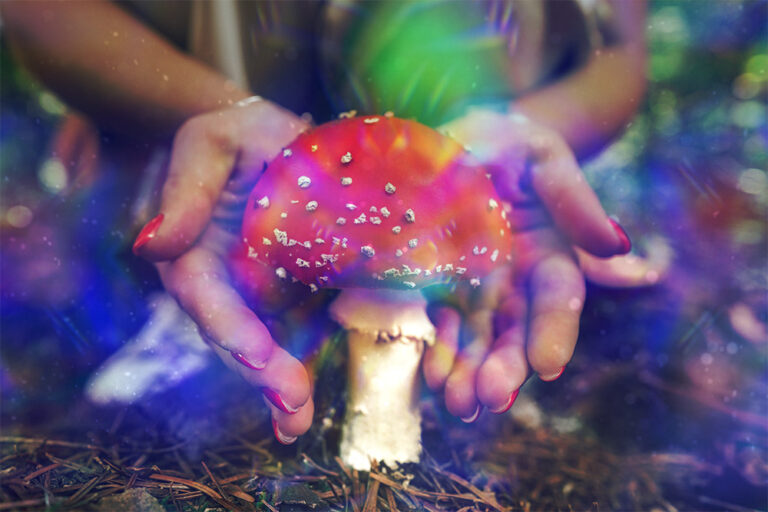
As for Amanda, she — like many other users who’ve rediscovered the sleep they’ve been missing — is keen on keeping the mushroom in heavy rotation and hopes Uncle Sam doesn’t “get stupid and criminalize it.”
At the time of print, amanita muscaria is legal in all states but one: In 2005, Louisiana’s State Act No 159 banned the cultivation, possession, and/or sale of 40 specific hallucinogenic plants, including amanita muscaria. However, there’s a caveat — the listed plants can be used for decorative, landscaping, and/or aesthetic purposes, a notion that “should be easy to get around,” according to Amanda.
Psilocybin, the “psychedelic” chemical compound in magic mushrooms, however, is currently illegal in 44 states: In California, Massachusetts, Washington , and Michigan, certain municipalities allow for its usage; in Oregon and Colorado, psilocybin is fully decriminalized. There’s a gnawing suspicion on mycology subreddits and Discord servers that amanita muscaria may go the way of magic mushrooms once the feds catch onto their growing popularity. A pity, that. One would reason that careful lab work under tight regulations would mitigate the boilerplate political hysteria shoehorned into state and federal debates on psychoactive mushroom consumption. Alas:
“The government wants us limited to chemicals their buddies in the pharmaceutical industry manufacture, and not something that grows freely and costs us nothing,” Amanda says before announcing it’s time for bed.
It doesn’t take a vision quest to figure that out.
1Name changed




